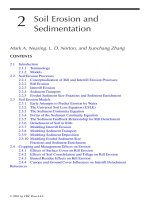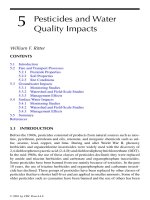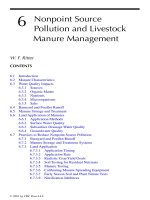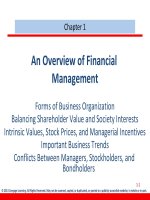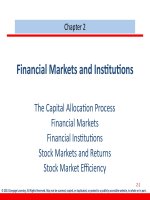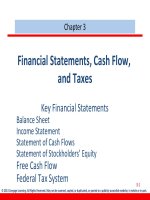Finance management cengage 2013 chapter 012
Bạn đang xem bản rút gọn của tài liệu. Xem và tải ngay bản đầy đủ của tài liệu tại đây (149.23 KB, 39 trang )
Chapter 12
Cash Flow Estimation and Risk
Analysis
Relevant Cash Flows
Incorporating Inflation
Types of Risk
Risk Analysis
12-1
© 2013 Cengage Learning. All Rights Reserved. May not be scanned, copied, or duplicated, or posted to a publicly accessible website, in whole or in part.
Proposed Project
•
Total depreciable cost
•
Changes in operating working capital
•
– Equipment: $200,000
– Shipping and installation: $40,000
– Inventories will rise by $25,000
– Accounts payable will rise by $5,000
Effect on operations
– New sales: 100,000 units/year @ $2/unit
– Variable cost: 60% of sales
12-2
© 2013 Cengage Learning. All Rights Reserved. May not be scanned, copied, or duplicated, or posted to a publicly accessible website, in whole or in part.
Proposed Project
•
Life of the project
•
•
Tax rate: 40%
– Economic life: 4 years
– Depreciable life: MACRS 3-year class
– Salvage value: $25,000
WACC: 10%
12-3
© 2013 Cengage Learning. All Rights Reserved. May not be scanned, copied, or duplicated, or posted to a publicly accessible website, in whole or in part.
Determining Project Value
•
Estimate relevant cash flows
– Calculating annual operating cash flows.
– Identifying changes in net operating working capital.
– Calculating terminal cash flows: after-tax salvage
value and return of NOWC.
0
1
2
3
4
Initial
Costs
OCF1
OCF2
OCF3
FCF0
FCF1
FCF2
FCF3
OCF4
+
Terminal
CFs
FCF4
12-4
© 2013 Cengage Learning. All Rights Reserved. May not be scanned, copied, or duplicated, or posted to a publicly accessible website, in whole or in part.
Initial Year Investment Outlays
•
•
Find ∆NOWC.
– in inventories of $25,000
– Funded partly by an in A/P of $5,000
– ∆NOWC = $25,000 – $5,000 = $20,000
Initial year outlays:
Equipment cost
-$200,000
Installation
-40,000
CAPEX -240,000
∆NOWC
-20,000
FCF0 -$260,000
12-5
© 2013 Cengage Learning. All Rights Reserved. May not be scanned, copied, or duplicated, or posted to a publicly accessible website, in whole or in part.
Determining Annual Depreciation Expense
Year
1
2
3
4
Rate
0.33
0.45
0.15
0.07
1.00
x
x
x
x
x
Basis
$240
240
240
240
Deprec.
$ 79
108
36
17
$240
Due to the MACRS ½-year convention, a 3-year asset is
depreciated over 4 years.
12-6
© 2013 Cengage Learning. All Rights Reserved. May not be scanned, copied, or duplicated, or posted to a publicly accessible website, in whole or in part.
Project Operating Cash Flows
(Thousands of dollars)
1
2
Revenues
200.0
– Op. costs
-120.0
– Depreciation
200.0
3
4
200.0
200.0
-120.0 -120.0 -120.0
-79.2
-108.0
-36.0
-16.8
EBIT
0.8
-28.0
44.0
63.2
– Taxes (40%)
0.3
-11.2
17.6
25.3
EBIT(1 – T)
0.5
-16.8
26.4
37.9
+ Depreciation
79.2
108.0
36.0
16.8
EBIT(1 – T) + DEP
79.7
91.2
62.4
54.7
12-7
© 2013 Cengage Learning. All Rights Reserved. May not be scanned, copied, or duplicated, or posted to a publicly accessible website, in whole or in part.
Terminal Cash Flows
(Thousands of dollars)
Salvage value
– Tax on SV (40%)
AT salvage value
+ ∆NOWC
Terminal CF
FCF4
$25
10
$15
20
$35
= EBIT(1 – T) + DEP – CAPEX – ∆NOWC
= $54.7 + $35
= $89.7
12-8
© 2013 Cengage Learning. All Rights Reserved. May not be scanned, copied, or duplicated, or posted to a publicly accessible website, in whole or in part.
Terminal Cash Flows
Q. How is NOWC recovered?
Q. Is there always a tax on SV?
Q. Is the tax on SV ever a positive cash flow?
12-9
© 2013 Cengage Learning. All Rights Reserved. May not be scanned, copied, or duplicated, or posted to a publicly accessible website, in whole or in part.
Should financing effects be included in cash flows?
•
No, dividends and interest expense should not be
included in the analysis.
•
Financing effects have already been taken into
account by discounting cash flows at the WACC of
10%.
•
Deducting interest expense and dividends would be
“double counting” financing costs.
12-10
© 2013 Cengage Learning. All Rights Reserved. May not be scanned, copied, or duplicated, or posted to a publicly accessible website, in whole or in part.
Should a $50,000 improvement cost from the
previous year be included in the analysis?
•
No, the building improvement cost is a sunk cost
and should not be considered.
•
This analysis should only include incremental
investment.
12-11
© 2013 Cengage Learning. All Rights Reserved. May not be scanned, copied, or duplicated, or posted to a publicly accessible website, in whole or in part.
If the facility could be leased out for $25,000 per
year, would this affect the analysis?
•
Yes, by accepting the project, the firm foregoes a
possible annual cash flow of $25,000, which is an
opportunity cost to be charged to the project.
•
The relevant cash flow is the annual after-tax
opportunity cost.
A-T opportunity cost:
= $25,000(1 – T)
= $25,000(0.6)
= $15,000
12-12
© 2013 Cengage Learning. All Rights Reserved. May not be scanned, copied, or duplicated, or posted to a publicly accessible website, in whole or in part.
If the new product line decreases the sales of the firm’s
other lines, would this affect the analysis?
•
Yes. The effect on other projects’ CFs is an
“externality.”
•
Net CF loss per year on other lines would be a cost
to this project.
•
Externalities can be positive (in the case of
complements) or negative (substitutes).
12-13
© 2013 Cengage Learning. All Rights Reserved. May not be scanned, copied, or duplicated, or posted to a publicly accessible website, in whole or in part.
Proposed Project’s Cash Flow Time Line
(Thousands of dollars)
0
1
-260
•
79.7
2
3
4
91.2
62.4
89.7
Enter CFs into calculator CFLO register, and enter
I/YR = 10%.
NPV = -$4.03
IRR = 9.3%
MIRR = 9.6%
Payback = 3.3 years
12-14
© 2013 Cengage Learning. All Rights Reserved. May not be scanned, copied, or duplicated, or posted to a publicly accessible website, in whole or in part.
If this were a replacement rather than a new project,
would the analysis change?
•
Yes, the old equipment would be sold, and new
equipment purchased.
•
The incremental CFs would be the changes from the
old to the new situation.
•
The relevant depreciation expense would be the
change with the new equipment.
•
If the old machine was sold, the firm would not
receive the SV at the end of the machine’s life. This
is the opportunity cost for the replacement project.
12-15
© 2013 Cengage Learning. All Rights Reserved. May not be scanned, copied, or duplicated, or posted to a publicly accessible website, in whole or in part.
What are the 3 types of project risk?
•
•
•
Stand-alone risk
Corporate risk
Market risk
12-16
© 2013 Cengage Learning. All Rights Reserved. May not be scanned, copied, or duplicated, or posted to a publicly accessible website, in whole or in part.
What is stand-alone risk?
•
The project’s total risk, if it were operated
independently.
•
Usually measured by standard deviation (or
coefficient of variation).
•
However, it ignores the firm’s diversification among
projects and investors’ diversification among firms.
12-17
© 2013 Cengage Learning. All Rights Reserved. May not be scanned, copied, or duplicated, or posted to a publicly accessible website, in whole or in part.
What is corporate risk?
•
The project’s risk when considering the firm’s other
projects, i.e., diversification within the firm.
•
Corporate risk is a function of the project’s NPV and
standard deviation and its correlation with the
returns on other firm projects.
12-18
© 2013 Cengage Learning. All Rights Reserved. May not be scanned, copied, or duplicated, or posted to a publicly accessible website, in whole or in part.
What is market risk?
•
•
The project’s risk to a well-diversified investor.
Theoretically, it is measured by the project’s beta
and it considers both corporate and stockholder
diversification.
12-19
© 2013 Cengage Learning. All Rights Reserved. May not be scanned, copied, or duplicated, or posted to a publicly accessible website, in whole or in part.
Which type of risk is most relevant?
•
Market risk is the most relevant risk for capital
projects, because management’s primary goal is
shareholder wealth maximization.
•
However, since corporate risk affects creditors,
customers, suppliers, and employees, it should not
be completely ignored.
12-20
© 2013 Cengage Learning. All Rights Reserved. May not be scanned, copied, or duplicated, or posted to a publicly accessible website, in whole or in part.
Which risk is the easiest to measure?
•
Stand-alone risk is the easiest to measure. Firms
often focus on stand-alone risk when making
capital budgeting decisions.
•
Focusing on stand-alone risk is not theoretically
correct, but it does not necessarily lead to poor
decisions.
12-21
© 2013 Cengage Learning. All Rights Reserved. May not be scanned, copied, or duplicated, or posted to a publicly accessible website, in whole or in part.
Are the three types of risk generally highly
correlated?
•
Yes, since most projects the firm undertakes are in
its core business, stand-alone risk is likely to be
highly correlated with its corporate risk.
•
In addition, corporate risk is likely to be highly
correlated with its market risk.
12-22
© 2013 Cengage Learning. All Rights Reserved. May not be scanned, copied, or duplicated, or posted to a publicly accessible website, in whole or in part.
What is sensitivity analysis?
•
Sensitivity analysis measures the effect of changes
in a variable on the project’s NPV.
•
To perform a sensitivity analysis, all variables are
fixed at their expected values, except for the
variable in question which is allowed to fluctuate.
•
Resulting changes in NPV are noted.
12-23
© 2013 Cengage Learning. All Rights Reserved. May not be scanned, copied, or duplicated, or posted to a publicly accessible website, in whole or in part.
What are the advantages and disadvantages of
sensitivity analysis?
•
Advantage
– Identifies variables that may have the greatest
potential impact on profitability and allows
management to focus on these variables.
•
Disadvantages
– Does not reflect the effects of diversification.
– Does not incorporate any information about the
possible magnitude of the forecast errors.
12-24
© 2013 Cengage Learning. All Rights Reserved. May not be scanned, copied, or duplicated, or posted to a publicly accessible website, in whole or in part.
Evaluating Projects with Unequal Lives
•
Machines A and B are mutually exclusive, and will be
repurchased. If WACC = 10%, which is better?
Year
0
1
2
Expected Net CFs
Machine A
Machine B
($50,000)
($50,000)
17,500
34,000
17,500
27,500
12-25
3
–
© 2013 Cengage Learning. All Rights Reserved. May not be scanned, copied, or duplicated, or posted to a publicly accessible website, in whole or in part.
17,500
